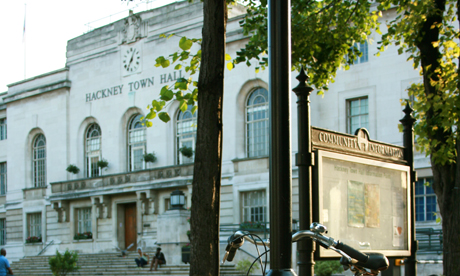Hackney’s population up by 19% in 10 years

Hackney Town Hall. Photograph: Hackney Citizen
Hackney’s population has leapt dramatically in recent years to almost a quarter of a million.
There are now 246,300 people living in the borough, according to newly-released figures from last year’s census. This compares with 207,200 people counted in the 2001 census, and means there has been an 18.9 per cent recorded increase over the course of the past decade.
The figures also show the official population of the the borough is 14 per cent higher than the mid-year estimates that have been used to calculate council funding allocations from central Government.
The ONS data reveals that population density in Hackney is among the highest in the country. At 12,930 per square kilometre, the borough ranks third in England after Islington and Kensington and Chelsea.
The average density in England as a whole is only 407.
The figures also show Hackney to be a young borough. There are 19,200 children under the age of four, 29,300 aged 5-14, 180,500 aged 15-64 and 17,300 over 65s.
This means that just 7.0 per cent of Hackney residents are retirement-age, as against an England-wide average of 16.3 per cent.
The report from the Office of National Statistics (ONS) reveals 86 per cent of households in Hackney returned their census form last year, compared to just 72 per cent during the last census in 2001.
The census is a count of an area’s population, carried out by the Office for National Statistics every ten years. This is used by the Government to calculate how much funding Hackney should receive for public services.
Concerned that the census might under-count the population, Hackney Council last year commissioned its own private population study, carried out by Professor Les Mayhew at Neighbourhood Knowledge Management, at a cost of £43,000.
This showed the borough to be home to 237,646 people, which is 3.5 per cent lower than the census figures.
A spokesperson for Hackney Council said: “In Hackney we’ve historically had an undercount which meant over the last decade the area has potentially missed out on hundreds of millions of pounds of funding, as these figures are used by the Government to determine funding allocations.
“To ensure we got a realistic population figure for effective service planning, the council commissioned the Mayhew Study which provided details on the population not available via census data. This study formed a key part of quality assuring the census results with the ONS .
“The council also joined forces with the ONS in preparing the census and reminding residents of the importance of filling in the form. As a result of this joint working the census count is up 14 per cent, giving the Government a more accurate reflection of Hackney’s population and the council the opportunity to ensure Hackney residents get their fair share of funding for vital services.”
The council justified the cost on the grounds that the Mayhew Study provided detail on the population which is not available via census data and which is important in planning services effectively.
For example, the Mayhew study provides information on population change and migration, housing need and benefit claimants, and population growth in specific locations of the borough.
Furthermore, data from the Mayhew population study was available for use by the Council in 2011, while the majority of detailed census data that is relevant for service planning will not be available until 2013.
